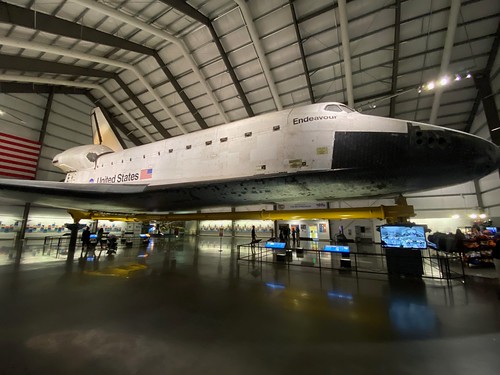
Today I went to the California Science Center — a free Los Angeles museum mostly aimed at kids — to see something pretty amazing: a Space Shuttle that flew 25 missions in space.
Looking back it’s easy to see the Space Shuttle program as a weird quirk of space travel history, or at worst as a total flop. It was however the only part of the much more ambitious Space Transportation System (STS) program from the late 1960’s to actually get built and used, so it could also be argued it was a modest success from a certain vantage point of history.
Unfortunately two of the Space Shuttles didn’t make it — the Challenger blew up seconds after liftoff on its 10th mission in 1986, and the Columbia broke apart upon re-entry after its 28th mission in 2003.
The Endeavour was ordered in the wake of the Challenger disaster. In those days the Space Shuttle program was still in full swing and a replacement was needed — the Endeavour would be the last one ever built.
And yes, for the record it’s spelled “Endeavour,” not “Endeavor” despite the latter being the American English spelling of the word. It was named in honor of a ship sailed by Captain Cook in the 18th century, hence the British spelling.
The museum also has an external fuel tank outside. In the near future they plan to exhibit the Endeavour with the fuel tank and two mock solid rocket boosters, but the building for this is not complete.
Seeing it up close the Endeavour looks like an airplane, but of course that’s completely misleading, and a sign in the museum points this out: after taking off straight up strapped to rockets, the wings were only there so it could land like an airplane… kind of. In order to de-orbit it had to do a barrel roll, and as a safety measure that began with the Endeavour it also had a parachute pop out the back to add additional drag.
One interesting aspect of the exhibit is a short film that shows how the Endeavour as well as the fuel tank were delivered to the California Science Center. The Endeavour was strapped to the top of a 747 and flown in, as NASA used to do to in order to move the shuttles between launch pads. The fuel tank was put on a giant barge and shipped through the Panama Canal and up to Marina Del Rey. From there they both had to be placed on giant flatbed trucks and slowly towed in, which meant moving telephone cables, street lights, chopping down trees, and closing streets in order to clear enough space.
The film shows the Endeavor slowly inching along as curious onlookers gather to see this crazy historic event.

In one corner there’s an engine on display. These are about the size of a small car, and each Space Shuttle had three of them. NASA had plenty of extras on hand and they were apparently relatively easy to swap out for maintenance.
These engines were one of the more successful parts of the Space Shuttle program and will likely be used again in the future.

Although the above photo may look like a futuristic torture device, that’s actually a Space Shuttle toilet. According to the description there’s a very small hole for defecation, and a hose for urine. Light suction was used to make sure the cabin air was not contaminated.
It’s an interesting reminder that humans aren’t really meant for zero gravity environments.

Around the interior of the building containing the Endeavour are photos of the crews of each STS mission with a short description of what happened and which Space Shuttle was used. The two disastrous missions show the deceased crew in black and white photos.
One aspect of this I hadn’t considered is the number of people onboard increased toward the end of the program, as the Space Shuttles were later used primarily for bringing people, supplies, and experiments to and from the International Space Station.
My one criticism of the exhibit as it currently stands is it doesn’t really touch on the International Space Station all that much, and yet it was clearly the most successful part of the entire Space Shuttle Program. Not only has it outlived the program, it got Russia and the US to cooperate on a major project. It’s a shame we don’t do that more here on the ground.
